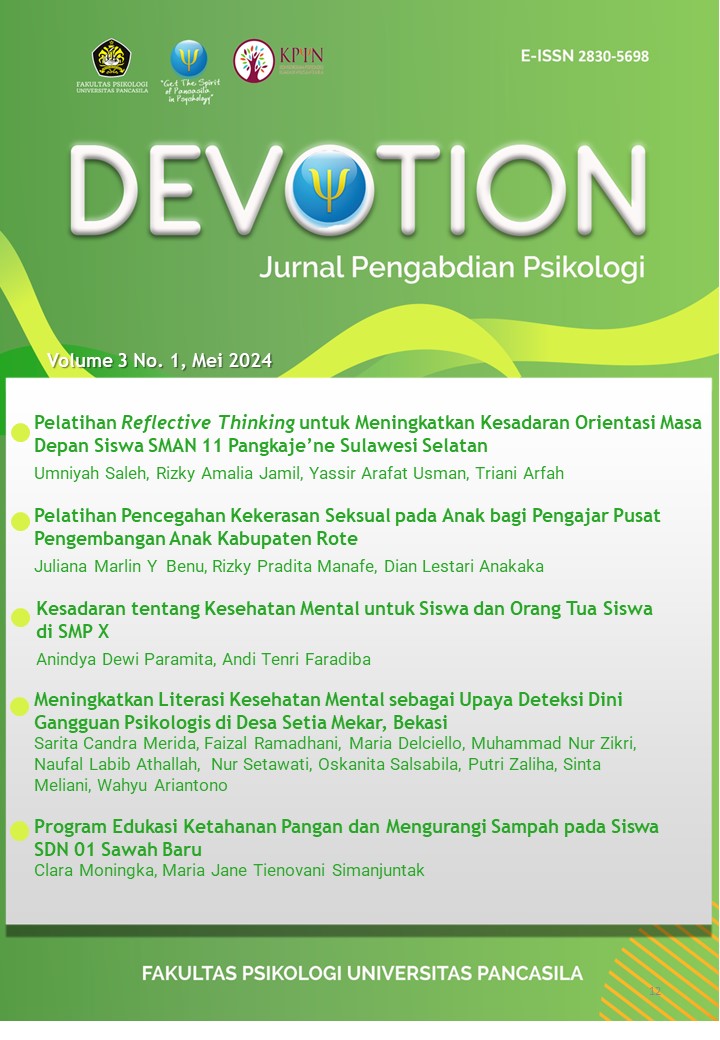Kesadaran tentang Kesehatan Mental untuk Siswa dan Orang Tua Siswa di SMP X
DOI:
https://doi.org/10.35814/devotion.v3i01.5868Keywords:
adolescentes, mental health, parents, psychoeducation, studentsAbstract
Many factors contribute to adolescents’ mental health, from changes within themselves to the outside world, which make adolescents vulnerable to mental health problems. In recent years, mental health issues have also begun to become a concern for educational institutions, including X Junior High School. In the last two years, several students have mental problems that interfere with their daily and academic functioning. Therefore, it is necessary to carry out some kind of follow-up action to prevent the development of mental health problems among students. Psychoeducational activities with the aim of increasing knowledge and awareness regarding maintaining mental health are carried out and provided to students and parents of grades VII and VIII face-to-face (offline) in the school. The results of this psychoeducation activity are that both students and parents have begun to demonstrate mental health literacy, although it is not yet comprehensive. Students know practical ways to deal with unpleasant situations, so it would be good if there was more specific training regarding self-management skills. At the end of the session the parents came to the conclusion that what is needed is not only understanding children who are in their teenage years but also considering what forms of interaction and assistance are suitable and acceptable for children. In the future, similar activities are also needed for schools to create a supportive environment for adolescents.
References
Balitbangkes RI. (2018). Laporan Riskesdas 2018 Nasional.pdf. In Lembaga Penerbit Balitbangkes (p. hal 156).
Center for Reproductive Health, University of Queensland, & Johns Bloomberg Hopkins School of Public Health. (2022). Indonesia – National Adolescent Mental Health Survey (I-NAMHS): Laporan Penelitian.
Chen, Y. F., Huang, X. Y., Chien, C. H., & Cheng, J. F. (2017). The effectiveness of diaphragmatic breathing relaxation training for reducing anxiety. Perspectives in Psychiatric Care, 53(4), 329–336. https://doi.org/10.1111/ppc.12184
Fitriyani, F. N., & Mustikasari, M. (2023). Hubungan dukungan sosial dan kecerdasan emosional terhadap tingkat stres siswa smp di jakarta timur. Jurnal Persatuan Perawat Nasional Indonesia (JPPNI), 8(2), 73. https://doi.org/10.32419/jppni.v8i2.471
Gilbert, P., & Irons, C. (2008). Shame, self-criticism, and self-compassion in adolescente. Adolescent emotional development and the emergence of depressive disorders. Adolescent Emotional Development and the Emergence of Depressive Disorders, 195–214.
Hamasaki, H. (2020). Effects of diaphragmatic breathing on health: A narrative review. Medicines, 7(10), 65. https://doi.org/10.3390/medicines7100065
Hollin, C. R. (2017). Cognitive behavior therapy. In Forensic Psychiatry: Fundamentals and Clinical Practice. https://doi.org/10.1201/9781315380797
Islami, Z. (2022, Maret 12). 100 SMP Terbaik di Indonesia, Dinilai dari Hasil (UNBK). Viva.co.id: https://www.viva.co.id/edukasi/1456845-smp-terbaik-di-indonesia
Hassett, A., Green, C., & Zundel, T. (2018). Parental involvement: A grounded theory of the role of parents in adolescent help seeking for mental health problems. SAGE Open, 8(4), 215824401880778. doi:10.1177/2158244018807786
Jorm, A. F. (2012). Mental health literacy; empowering the community to take action for better mental health. American Psychologist, 67(3), 231–243. https://doi.org/10.1037/a0025957
Ma, K.K.Y., Anderson, J.K., & Burn, A. (2023). Review: School-based interventions to improve mental health literacy and reduce mental health stigma - a systematic review. Child and Adolescent Mental Health, Vol. 2 (2), 230-240. https://doi.org/10.1111/camh.12543
Mackova, J., Veselska, Z.D., Geckova, A.M., Jansen, D.E.M.C., van Dijk, J.P., dan Reijneveld, S.A. (2022). The role of parents in the care for adolescent suffering from emotional and behavioral problems. Front Psychology, 13:1049247. doi: 10.3389/fpsyg.2022.1049247.
Nuraenah, Widakdo, G., Naryati, Aisyah, Fadhillah, H., Adelia, A., & Adelia, M. (2023). Edukasi kesehatan mental (masalah psikososial) pada remaja. Jurnal Kreativitas Pengabdian Kepada Masyarakat (PKM), 6(10), 4307–4316.
Pakaya, N., Eka, A., Nento, P., Gorontalo, U. N., & Timur, D. (2023). The effectiveness of diaphragmatic breathing exercise slow. 4(1), 119–126.
Papalia, D. E., & Martorell, G. (2023). Experience human development. McGraw Hill.
Paramita, A.D. (2023). Kesehatan mental remaja indonesia (presentasi karya tulis). Temu Ilmiah Nasional Ikatan Psikolog Klinis V 2023, Bali, Indonesia.
Payne, R. A. (2005). Relaxation techniques: a practical handbook for the health care professional. Elsevier.
Putrawan, N.M.R. (2020). Regulasi emosi siswa dalam menghadapi masa transisi dari SD menuju SMP/Mts. Publikasi Ilmiah Prodi Psikologi Fakultas Psikologi Universitas Muhammadiyah Surakarta. Tidak dipublikasikan.
Ryman, L. (1995). Relaxation and visualization. In D. Rankin-Box (Ed.) The Nurse's Book of Complementary Therapies (pp. 141-148). Churchill Livingstone.
Veit, C. T., & Ware, J. E. (1983). The structure of psychological distress and well-being in general populations. Journal of Consulting and Clinical Psychology, 51(5), 730– 742.
World Health Organization. (2021, November 17). Mental health of adolescents. https://www.who.int/news-room/fact-sheets/detail/adolescent-mental-health
World Health Organization. (2022, Juni 17). Mental health. https://www.who.int/news-room/fact-sheets/detail/mental-health-strengthening-our-response









